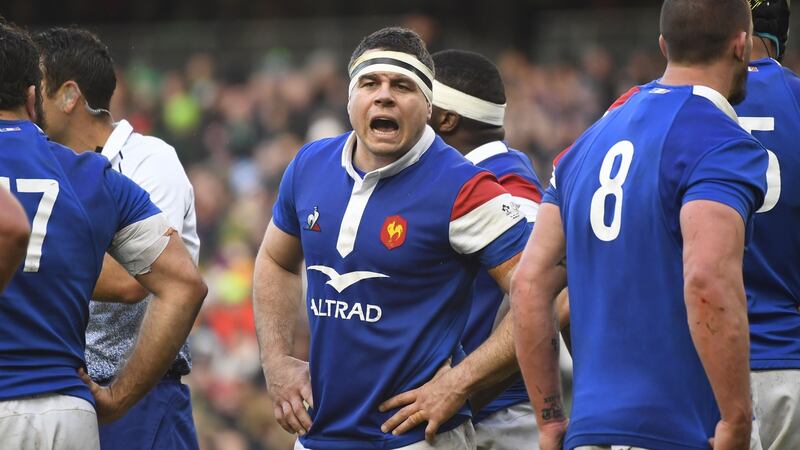A primary goal for Ireland was to concentrate purely on the 80 minutes against France without reference to what had gone before in the Six Nations. No baggage, just a singular focus on producing a performance that was representative of the team's quality.
Joe Schmidt’s side set the tone from the opening whistle, physical, precise and aggressive with clarity of purpose to their patterns. Their multifaceted playbook quickly drained French confidence and they attacked the visitors in areas that would cause them maximum discomfort.
Ireland sought to play with a high tempo, keeping the ball moving as evidenced by tip-on passes just before contact and mixing frontal assaults with nicely judged screen plays that sought to create and exploit space in the wider channels.
There is a danger in evaluating the merit of a victory primarily through the imperfections of the opposition. France weren’t good on the day but the majority of their issues came from the pressure which Ireland exerted. The French demonstrated late on when, the home side had mentally retired to the dressingroom, they can play when left to do so.
Ireland didn’t pillage as many points as they might, unlucky once or twice, and on a couple of occasions the choice of, or execution of, a pass wasn’t up to scratch.
Setting traps
Two of Ireland's tries were honed on the training ground and carried out perfectly, the first from Johnny Sexton. The component parts of the move required Garry Ringrose to make the French think that Jordan Larmour, cutting a line back against the grain was the intended recipient, rather than Sexton coming around on the loop.
Ringrose and Larmour executed their roles superbly and Sexton, who had a fine game, scampered over, untouched, for the try. Keith Earls’s try, his 30th for Ireland, also came from a trap play. CJ Stander explained afterwards that they were going to use it in the first half but changed the call. Second time around Earls once again took up a position at the front of the lineout and hidden in plain sight, he accelerated on to Stander’s nicely timed inside pass to shoot through the hole and cross for the try.
It'll be interesting to see what kinks Schmidt has spotted in a Welsh defence in which Hadleigh Parkes and in particular Jonathan Davies effectively shut down Scotland's attack with one exception, the Darcy Graham try, that came from an inside pass to the blindside winger, taking a line inside the outhalf.
Final warnings
When is a final warning not a final warning? Answer: when it's issued more than once during a match. Sunday's referee New Zealander Ben O'Keeffe called over French captain Guilhem Guirado during the first half after the visitors had conceded a handful of penalties on the bounce, warning the hooker that they'd lose a player if they infringed again.
France conceded four more penalties either side of half-time and still there was no sanction until replacement prop Dorian Aldegheri was penalised four times in succession during a sequence of scrums close to the French line and eventually received a yellow card.
O’Keeffe communicated clearly but a frustration for players is when a referee issues a final warning to a team but doesn’t follow through. It can lead to players appealing for cards and that is certainly not something that would benefit the sport.

Offside line
A bugbear throughout the tournament has been that the offside line has only periodically been policed and this hasn’t helped the spectacle. Referees need their assistants to be more vigilant and even if it means a slew of penalties across several matches, the game will benefit from a more rigorous application of the existing laws.
Players are also getting away with being bound with hands rather than shoulders at rucks as the scrumhalf works the ball back into a different postcode so that he can box-kick. If they are bound only by hands then the ball is out and referees need to identify this more consistently.
Clearing out
The Ireland players cleared out with venom at breakdown – take a bow Tadhg Furlong – against France ensuring quick ball and this was a central tenet in allowing the Irish backline to flourish and underpinned the victory. There was a notable improvement in this facet of Ireland's game on Sunday.
It will be vital that the Irish players back up effectively in Cardiff on Saturday because Wales are very effective at the breakdown in slowing down or pilfering ball as they have demonstrated consistently and it’s not just limited to their backrow poachers.
Set piece
Ireland dominated the French scrum and were rewarded lavishly. The lineout was also excellent (lost one from 18) as was the ensuing driven maul and it’s certainly an area that they can put huge pressure on Wales. The Welsh lineout has struggled to win clean ball, resorting to a few trick options, to a point where they tend to kick down the pitch rather than put the ball out of play.
Next Saturday’s visitors to Cardiff may look at kicking to the corners and getting after the Welsh lineout, something that’s been productive for other sides in this season’s tournament.












